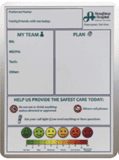5 Ways to Keep Your Birth Plan From Ruining Your Day
SEPTEMBER 26, 2021 BY JULIANA PARKER, RNC-OB, C-EFM
Do not consider the opinions expressed here as medical advice (click to read more)
Writing a birth plan is a decision that some expectant parents make in preparation for their labor and birth. It is a document that outlines, sometimes elaborately detailed, sometimes minimially detailed, the plan for their baby’s birth. It may include details about movement, pain management, their stance on induction or any other interventions that may be used during labor. It may also outline their after-birth preferences.
After 17-years of being a labor and delivery nurse, I have seen a large variety of birth plans. Some that are very simplistic with pictures that resemble a bingo card and some that resemble a 5-page essay outlining every detail of their birth.
Many labor and delivery nurses (and doctors) do not love birth plans. Why you might ask? Because when plans don’t go as expected, it tends to create negative feelings about the day your baby is born.
It is similar to planning a large event. You may put a lot of thought, effort and prep into an event, but honestly ask yourself, how often does everything go exactly as you expected?
Most people feel stress and anxiety when things do not go as planned in labor. And as mentioned before, it tends to leave them feeling with negative feelings. Therefore, heath care teams are typically not huge fans of birth plans.

But not to worry, with just a few adjustments, “birth plans” don’t have to ruin your day! In addition, some small adjustments will also allow for a better reception by your healthcare team and can become very useful tools. So here are some tips for you, the expectant mom who would like to write a birth plan.
1. CHANGE YOUR TITLE FROM BIRTH PLAN TO BIRTH PREFERENCES
My first piece of advice is to rename your birth plan to birth preferences. As a new parent, you will quickly learn that your baby is the boss, and this is your first of many lessons involving this fun little fact. You will indeed be reminded of this many times in the years to come. Therefore, you can’t actually “plan” your birth.
The requests on your birth plan are decided by how well your baby is tolerating labor. If your baby loves labor and you have a healthy pregnancy with no high-risk conditions, then you will likely have a lot of latitude on your birth plan (preferences). But if your baby shows the slightest sign of stress or if your blood pressure suddenly creeps up at the end of your pregnancy, your “plan” may go out the window.
So let’s name it what it actually is, your birth preferences. This simple play on words does a few things:
1. Makes this a wish list instead of a to do list.
 2. If you don’t get everything on your wish list, it’s mentally not as detrimental as things not going according to plan.
2. If you don’t get everything on your wish list, it’s mentally not as detrimental as things not going according to plan.
3. Your healthcare team will be much more receptive because they know you are simply sharing your preferences. It will seem less demanding and more understanding.
4. It non-verbally communicates with your staff that you realize that your baby’s safety comes first.
It’s amazing how a simple little wording change can make such a big difference!
2. KEEP YOUR BIRTH PREFERENCES FLEXIBLE
While your health care team will read your preference sheet and make their best effort to reach your goals, remember again, your baby is the boss. This may mean that one or more of your requests may be delayed, revised or worst-case scenario deleted all together.
Here’s an example I’ve seen before – I’ll be the patient. Let’s say I’m pregnant with Baby Billy and I wrote a birth preference sheet that requested skin-to-skin contact immediately after birth for the first hour. Sounds amazing for me and my baby and the nursing staff would love nothing more than to make that happen! But Baby Billy has different plans. Baby Billy decided to play around with his umbilical cord, and get it wrapped around his neck and his foot (yes this has happened).
Even so, everything was going peachy until we started to push when the health care team noticed that Baby Billy was not tolerating pushing very well and was beginning to look a little tired and worn. But the good news is, we are close to delivery. So my doctor says, “Baby Billy needs to be born now instead of 30 minutes from now. I can use a vacuum to assist or we can do a c-section.” I agreed to a vacuum which basically gives the neonatology team an invitation to Baby Billy’s birthday party. (A c-section would have invited them as well.)
With strong pushes and a few pulls from my doctor, Baby Billy is born at 5:00pm but because of the stress of the delivery and the vacuum, Baby Billy needs a little help breathing (one of the reasons the Neo team is there).
 Neo does their magic and Baby Billy is screaming and crying but is still using some accessory muscles to breath. As a result, the Neo team does not bring him to me quite yet. They wait with him in my labor room until he transitions through.
Neo does their magic and Baby Billy is screaming and crying but is still using some accessory muscles to breath. As a result, the Neo team does not bring him to me quite yet. They wait with him in my labor room until he transitions through.
Finally, at 5:30pm, Baby Billy is brought to me and I have my first opportunity to hold him and do skin-to-skin. My preference was immediate skin-to-skin contact, but I’ll still take delayed skin-to-skin because I kept things flexible and it is what was best for Baby Billy.
3. COMMUNICATE WITH YOUR HEALTHCARE TEAM
Whether you are using a doctor or a midwife, communication is key. Talk to your provider during your prenatal visits about the things you are most passionate about. For example, if you prefer not to have an episiotomy, during your prenatal visit, ask your provider if cutting an episiotomy is part of their routine delivery practice. If it is, you should inform them you would prefer not to have one and ask if they support that decision.
Most providers will flex their practice if you inform them and communicate, but it’s better to have these conversations while you are not in labor and not in the moment.
Here are a few questions you may use (“procedure” = any topic you would like to discuss):
-
When do you use that procedure?
-
Can you explain how you do that procedure?
-
Is there any flex on whether or not you do that procedure?
-
Are there other options you would entertain that would give the same result?
-
What are the risks?
-
What are the benefits?
4. WRITE YOUR PREFERENCES ON THE WHITE BOARD IN YOUR ROOM
Most hospitals or birthing centers have a patient white board where you may write your preferences. The white board is an alternative way to present your preferences in lieu of a birth “plan”. You should use this board to write your preferences, especially the ones most important to you. When shifts change, this board is usually reviewed by your oncoming staff. It’s a quick reminder and easy way to share the most important preferences you have.
Since this white board is provided by the hospital to be used by the staff, it is well received and encouraged.
5. REMEMBER OUR GOAL AND FOCUS ON THE POSITIVES
The goal of your entire health care team is a healthy baby and a healthy mom. Trust me, we want nothing different. This sometimes means that your preferences may not be our first priority, but your safety and your baby’s safety definitely are! I encourage you to ask questions during your prenatal visits as this is the best time to explore and learn about your provider. Once you are in labor, hopefully you and your provider have developed a trust that will allow you to relax and enjoy the process knowing your provider and you have already had the important discussions.

Remember, most events don’t go exactly as expected. Obviously, it can be disappointing when this happens. It’s okay to feel disappointment, but don’t let it consume you. The most important goal out of this entire day is that you and your baby are healthy.
Finally, don’t forget it is your baby’s birthday! Something you will be celebrating for years to come! So try to focus on your positives and give gratitude during the process for all of your wins (big or small). You have a beautiful baby and that is an incredibly positive outcome to be very grateful for!

IN CONCLUSION
View my version of a BIRTH PREFERENCE SHEET to help you get started. If you have any questions about the options of childbirth, sign up for my MASTER CHILDBIRTH CLASS. I share 17-years worth of labor and delivery experience and break each option down in an understandable, easy to digest approach. You will learn more in my classes than anywhere else! Guaranteed!
Featured Courses

The Childbirth Master Class
If you are pregnant and want a vaginal birth, with or without medication, then start here. Learn about the entire birthing process including all interventions and ways to increase your chance of success!

Elementary Newborn Care
If you have little or no experience with babies, then you won’t want to miss this program. We will cover everything you need to know about your newborn from simply holding to changing diapers!

Childproofing and CPR
Learn to set up a safe environment, avoid unintentional accidents and manage emergencies. You’ll learn how to save a life in less time than it takes to watch a great movie!


 2. If you don’t get everything on your wish list, it’s mentally not as detrimental as things not going according to plan.
2. If you don’t get everything on your wish list, it’s mentally not as detrimental as things not going according to plan. Neo does their magic and Baby Billy is screaming and crying but is still using some accessory muscles to breath. As a result, the Neo team does not bring him to me quite yet. They wait with him in my labor room until he transitions through.
Neo does their magic and Baby Billy is screaming and crying but is still using some accessory muscles to breath. As a result, the Neo team does not bring him to me quite yet. They wait with him in my labor room until he transitions through.


